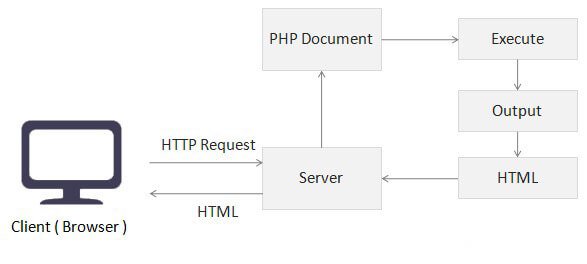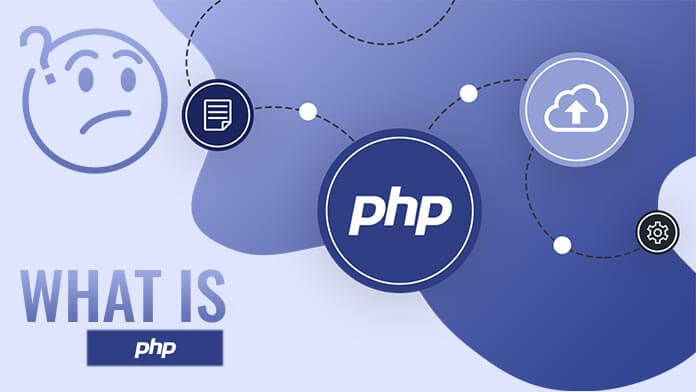Who invented PHP, how it works, answers to all such questions about PHP, and much other information, you are going to get here today. Hope this information will work for you.
What is PHP
The full form of PHP is PHP: Hypertext Preprocessor It is an open-source server-side scripting language that is used for web development.
In the past, PHP was a full-form Personal Home Page but currently, it has been changed to PHP: Hypertext Preprocessor. PHP was invented by Rasmus Lerdorf in 1994, to run PHP, a web server or client machine is needed such as Xampp, Wamp, etc.
As we have known in our previous article (What is HTML and What is CSS) what is the use them, HTML and CSS code can be seen on the website but the user cannot see the code of PHP because the code of PHP resides in the server PHP is a very powerful language. There are millions of websites on the internet using PHP. Almost all CMS like WordPress, Joomla, Drupal, etc. are built in PHP itself.
What is the use of PHP?
- Dynamic website or web application can be created in PHP.
- Browser’s cookies can be set and accessed via PHP.
- Browse’s cookies can be accessed by setting up PHP.
- Email can be sent and received via PHP.
- Data encryption and decryption can also be done through PHP.
- Through PHP, we can store user’s data in the database by filling data from the user through any of the forms.
- A user login system can also be created from this. And server side validation can also be done.
- A website can also be connected to the database with PHP.
- Files can be open, close, read and write in PHP.
- The PHP file is saved with the .php extension.
How does PHP work?
PHP is actually a software that is installed on a web server and works with a web server. It works to make software web pages accessible to a user. When we type the URL of a website in the search bar of our Web Browser, you are sending a message to the web server by entering that URL. As soon as the massage is read, the web server sends the Html file of that website to our web browser. gives. The browser reads the html file and displays the website’s web page in front of it. Here php acts as an interface.
What is meant by interface?
What is meant by the interface is that it converts the request sent in the server into machine language. Whenever a request for a file comes to the server, the php interpreter converts that code and accesses it in the database and picks up the file from there and sends it to the server. After which the server reaches that file to the user.
Whenever a user sends a request to the server for a PHP document through their web browser, the server first sends it to the PHP processor after finding out that document.
How many types of operations are performed in PHP?
It performs two types of operations:
- Copy mode: In this method, plain HTML is copied to the final output.
- interpreter mode: In this method, the code of PHP has executed the interpreter and the output it receives is added to the final output.

Advantages of PHP
- PHP is open-source, meaning we can download it for free.
- PHP supports all platforms such as can be used in Windows, Linux, Mac etc.
- Its execution speed is very fast.
- Its syntax is very easy so it can be learned very easily.
- PHP is compatible for both Apache and IIS servers.
- Almost all types of databases such as MySQL, Oracle etc. can be used with PHP.
- The best thing about PHP is that it does not cost much to host a website built in PHP.
Disadvantages of PHP
- Developing a large application from PHP is very difficult task because it is not highly modular due to which it becomes very difficult to manage a large application.
- PHP is open-source, meaning that hackers can easily see its source code. If there is some kind of bug in our website, if you are thinking of making your website in PHP, it is necessary that you solve all the bug / error of your website. do
History of PHP
In 1997, PHP 3.0 was released, which was the first version of PHP. After its arrival many of the limitations of PHP were over and then its name was changed from Personal Home Page to PHP Hypertext Preprocessor.
| Version | Release Date |
| 1.0 | 8 June 1995 |
| 2.0 | 1 November 1997 |
| 3.0 | 6 June 1998 |
| 4.0 | 22 May 2000 |
| 4.1 | 10 December 2001 |
| 4.2 | 22 April 2002 |
| 4.3 | 27 December 2002 |
| 4.4 | 11 July 2005 |
| 5.0 | 13 July 2004 |
| 5.1 | 24 November 2005 |
| 5.2 | 2 November 2006 |
| 5.3 | 30 June 2009 |
| 5.4 | 1 March 2012 |
| 5.5 | 20 June 2013 |
| 5.6 | 28 August 2014 |
| 6X | Not released |
| 7.0 | 3 December 2015 |
| 7.1 | 1 December 2016 |
| 7.2 | 30 November 2017 |
| 7.3 | 6 December 2018 |
| 7.4 | 28 November 2019 |
| 8.0 | 26 November 2020 |
Hello World Program In PHP
<!DOCTYPE html>
<html lang="en">
<head>
<meta charset="UTF-8">
<meta https-equiv="X-UA-Compatible" content="IE=edge">
<meta name="viewport" content="width=device-width, initial-scale=1.0">
<title>Hello World Program In PHP</title>
</head>
<body>
<?php
echo "Hello World";
?>
</body>
</html>Output:
Hello WorldWe hope you liked this article (What is PHP). You must keep your thoughts about this in the comment below and share this article with your friends.


